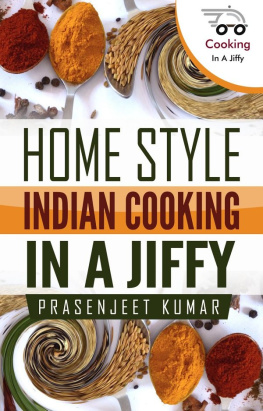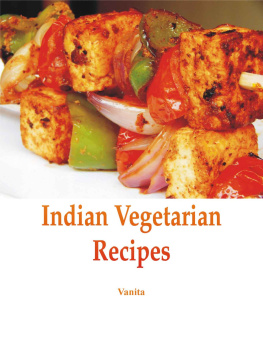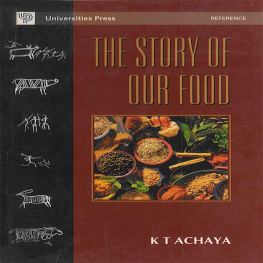EATING INDIA
BY THE SAME AUTHOR
Life and Food in Bengal
Bengali Cooking: Seasons and Festivals
Feeding the Gods: Memories of Food and Culture in Bengal
Land of Milk and Honey: Travels in the History of Indian Food
EATING INDIA
AN ODYSSEY INTO THE FOOD AND
CULTURE OF THE LAND OF SPICES
C HITRITA B ANERJI
BLOOMSBURY
Copyright 2007 by Chitrita Banerji
Illustrations copyright 2007 by Polly Napper
All rights reserved. No part of this book may be used or reproduced in any manner whatsoever without written permission from the publisher except in the case of brief quotations embodied in critical articles or reviews. For information address Bloomsbury USA, 175 Fifth Avenue, New York, NY 10010.
Published by Bloomsbury USA, New York Distributed to the trade by Holtzbrinck Publishers
All papers used by Bloomsbury USA are natural, recyclable products made from wood grown in well-managed forests. The manufacturing processes conform to the environmental regulations of the country of origin.
LIBRARY OF CONGRESS CATALOGING-IN-PUBLICATION DATA
Banerji, Chitrita.
Eating India : an odyssey into the food and culture of the land of spices / Chitrita Banerji.1st US. ed.
p. cm.
eISBN: 978-1-59691-712-5
1. DietIndia. 2. Food habitsIndia. 3. Cookery, Indie. 4. IndiaSocial life and customs. I. Title.
TX360.I4B255 2007
394.1'20954dc22
2007005650
First U.S. Edition 2007
1 3 5 7 9 10 8 6 4 2
Typeset by Westchester Book Group
Printed in the United States of America by Quebecor World Fairfield
For Jai
Cooking is at once the most and the least localized of the arts; it owes its development to commerce and to travel, and its preservation to stout regionalism; it must find its character in the resources at hand, yet may enrich these by some of the good things from outside. Every enlarging contribution was made by clever, articulate and traveled men, yet the burden is carried and handed on by obscure local women. The history of cooking, with its interchanges and migrations, is indeed hard to pin down.
Sybille Bedford, A Visit to Don Otavio
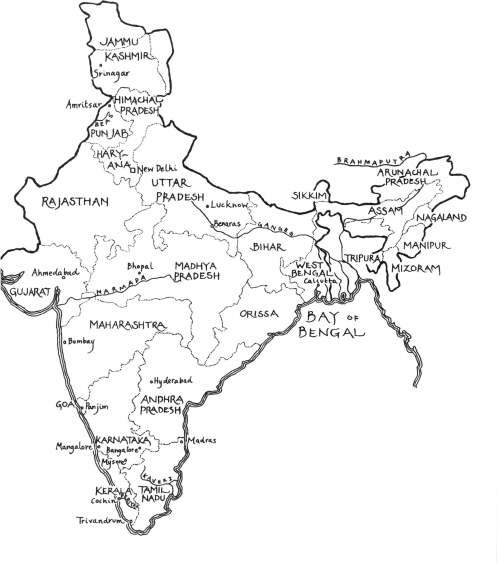
CONTENTS
This book is based on several trips I made to India between 2003 and 2006. My journeys there did not follow a linear chronological or geographical sequence; nor did I set out to write a comprehensive chronicle of the cuisines of India. My selection of destinations (some of which I visited more than once) and cuisines was based on what seemed to promise the most interesting revelations. My objective was to see how much authenticity in food and cookery could possibly survive in the changing, young-old, immigrant nation that is India.
For the convenience of readers who have not been to India, I have used the older, more familiar names and spellings of cities, towns, and rivers.
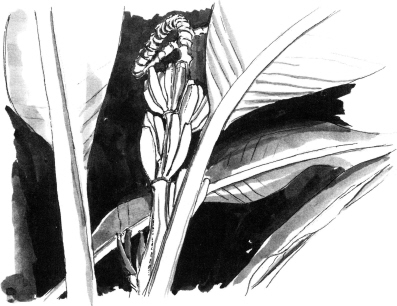
It was a frigid white morning in Boston. Sorting through a pile of mail, I had come upon a square beige envelope, one corner embossed with a colored illustrationa young banana plant, leaves drooping gracefully, standing next to an earthen pitcher with a green coconut on top. For Hindu families like mine, both banana and coconut are highly auspicious, and their presence is obligatory at most rituals and ceremonies. This envelope had to be an invitation of some kind. The card inside sported a large blue and gold butterfly, symbol of Brahma the Creator, patron saint of marriage and union. Opening the card, I read the invitation. The son of a longtime family friend in Calcutta was getting married. They wanted me to come.
I looked out of my window. Forlorn, leafless trees under a gray sky, piles of grungy snow on the street, people walking with the insular gait of a North American winterhead down, scarves pulled up to the nose, gloved hands in pockets for extra protection from the cutting chill. The mild, sunlit, gregarious cheer of winter in my native Bengal was utterly implausible in this landscape of solitude. I examined the card again. It felt like eons since I had taken part in a wedding in India. Not being closely connected to the Bengali/Indian community in Boston, I had also missed weddings at which the immigrant imagination tries to recreate ancient homegrown traditions. Should I make an exception by accepting this invitation, and how would I feel if I did?
As I kept staring at the card, a very different image rose before my eyesa luscious, rippling swath of green falling away from both sides of a green ridge. It was a freshly washed banana leaf on which a long sequence of foods was being served to be savored with eyes, nose, fingers, and mouth. Not just any old banana leaf, but the one off which I had eaten at my aunt's wedding many decades ago. From half a world away, half a lifetime back, it sent me an imperious summons to remember and relive. Time and space melted away to make me a small child seated at a trestle table, fingers eagerly poised to dip into the nutmeg- and mace-scented rice pilaf (or polao, as we called it in Bengali) heaped on the leaf. Around the pilaf was arranged a number of other items, each endowed with its own promise. For the child that I then was, the feast was the culmination of a long day filled with unsettling emotions, exquisite music, loud and chaotic activity, and, above all, color and smell.
The vision of this fragrant, opulent, sapid banquet lingered in my mind throughout the day. It not only revived numerous distant memories, it roiled my thoughts and feelings as if an expert cook was stirring my brain with her spatula. Or was it the hand of a dairymaidlike the ones who frolicked and flirted with the young god Krishna as described in mythologychurning cream for butter? Whatever the culinary metaphor, I found that the distant past was suddenly overwriting the present.
My aunt got married at a time when ceremonies were conducted at home, not in rented halls. Nobody seemed to mind the chaotic upheaval of realigned spaces, the bumping into upended furniture, or the crowds of relatives milling around for days. The roof of my grandparents' large, rambling four-story house was converted into a kitchen and banquet hall. Under a red and white canopy, the guests sat in front of long trestle tables. Bengalis, like most Indians, have always eaten with their fingers. Instead of plates and cutlery, each person was given a banana leaf. Rows of tiny lightbulbs strung up on bamboo poles illuminated droplets of water that lingered on the glossy surface after the leaf had been washed. On one corner of the leaf sat the discreet embroidery of a pinch of salt, a wedge of lime, and two green chilies. As the feast progressed and different items were served in the traditionally approved sequence, a tapestry of colors and textures came to life on the palette of basic green. The consumer became an actor in a painterly enterprise.
Eating off a banana leaf was a vastly different experience from eating out of a ceramic, porcelain, or metal plate. Your fingers got wedded to the sensory connotations of flaky luchis, soft vegetables, grainy legumes, and fluffy pilaf, even as your fingertips interacted with the silkiness of the leaf. When the pieces of carp or bhetki or other fish swimming in a redolent sauce were ladled out, you had to quickly blend the pilaf with them, lestthe sauce run away to the edge of the leaf and spill over on the table. As for the piece de resistance, a malaikari of enormous freshwater prawns, the green banana leaf provided a perfect foil for a melange of hues. Scarlet-orange shells covered the heads and tails of the prawns, contrasting with their pale flesh. The sauce that covered them was ruby red,gleaming with the richness of spices, coconut milk, ghee, and the coral oozing from the heads.
Next page
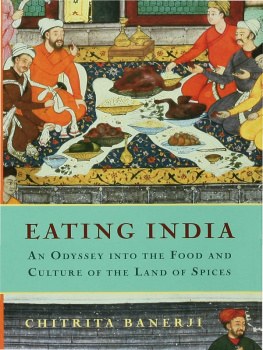
![Anita Jaisinghani - Masala: Recipes from India, the Land of Spices [A Cookbook]](/uploads/posts/book/320725/thumbs/anita-jaisinghani-masala-recipes-from-india-the.jpg)



